 |
|
|
 |
|
|

|
|
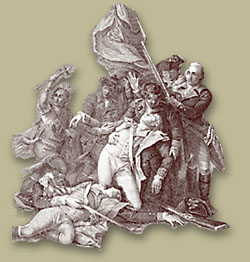
|
|
Major General Richard Montgomery |
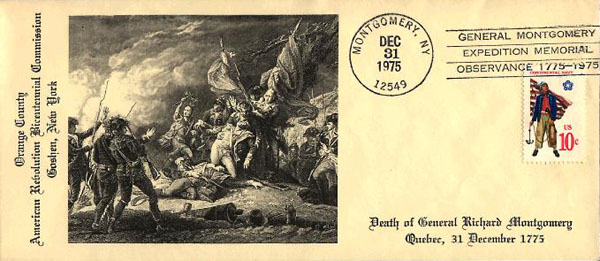
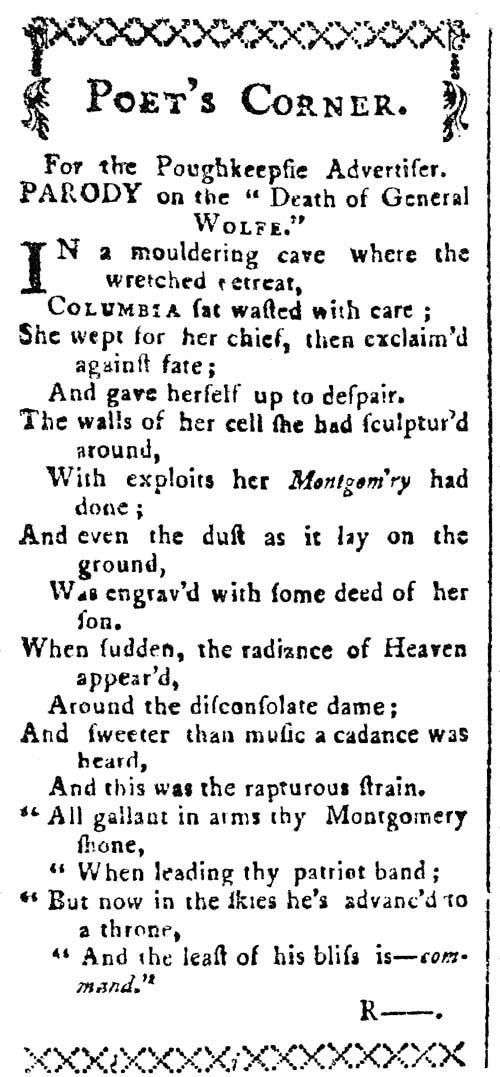
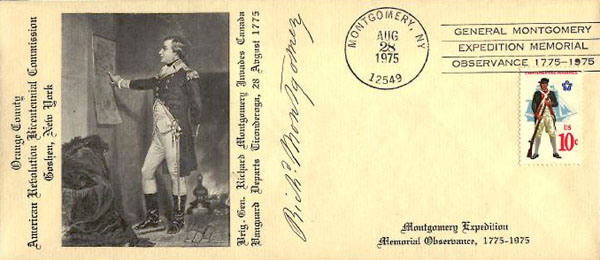
|
|
|
September 23. - We arrived at Gen. Montgomerys camp near noon, the weather very fine-got our Tents pitch’d and every
thing settled that afternoon. All I heard of war this day was a few shells thrown in the evening, for every one
we threw, Our Enemys generally return'd us 4.
October ll. - A Council of War held at the Generals Tent at which only the Field officers of the army attended. When the General recommended building a Battery west of the forts of St. John But the motion was unanimously opposed by the Officers who were of the opinion as one man, that a Battery erected on the east side of the lake opposite the Forts would make a greater impression on our enemys. On that points being carried the General Ordered Coll’o Clinton and 200 of his men to go upon that Business.
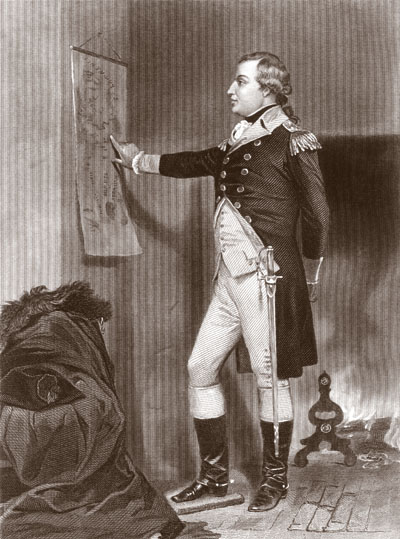 October 15, Sunday.- This morning we fired several Red-hot shot at the Schooner, but happily for us [her?] they went with such force that they flew quite thro her & lodg’d in the opposite bank- In the afternoon getting a supply of powder we fired on the Enemy briskly till evening & which they return’d chiefly with shells-Late in the night a Batteau was sent past the fort & down the falls, with a double fortified 9 pounder on board, to go to Chamblee which Fortress our people mere then beseiging. The General neglecting to give Coll’o Bedle (who lay 1 l/2 miles north of St. John) notice of her going down, she received 10 or 12 shot from his guards before they could make themselves known as friends. But no hurt was received. October 18--I Received orders from the General to march with 100 men of our Regiment to Caghnawaga to protect that nation from any Insults Carleton might offer them, & there were now 2 expresses in Camp who said that a considerable number of Regulars & Canadians (5 or 600) were on their march to the Caghnawaga Castle-To support the troops I took with me, He gave me L160 in Half Joes. Col’o Clinton gave me leave to choose any 2 companies to accompany me, that I could confide in most out of his Regiment & I pitch’d upon those of Cap’t Nicolson & Dubois, all of us together made 108 men. October 22.-Sent the 2 Canadian prisoners with Lt. {James] Gregg to the General, & 2 days after Cap’t Robinson with Cap’t Jn Nicolson. November 6.(1)-General Montgomery arrived in Town [Lapraire] at 2 OClock, & at different times of the day the 1st & our Battalion. November 13-This day at 10 0 Clock General Montgomery marched into Montreal. November 15.-A Council of War held by the General at the India House. [Henry and a great number of the other officers and men left the army following this meeting, as their terms of enlistment were over.] |
|
|
|
MONTGOMERY, Richard, Revolutionary soldier, was born at Convoy House, near Raphoe, county Donegal, Ireland, Dec. 2, 1736; son of Thomas Montgomery, a member of the British parliament from Lifford. He was graduated from Trinity college, Dublin, and entered the 17th regiment of foot as ensign, Aug. 21, 1756. His regiment was ordered to Halifax, N.S., and he took part in the siege of Louisburg under Gen. James Wolfe in 1758. He was promoted lieutenant for his bravery on this
occasion, and in 1759 he joined the expedition under Sir Jeffrey Amherst to relieve General Abercrombie. He served in the command of Colonel Haviland in the capture of Fort Ticonderoga in July, Crown Point in August, and Montreal, Sept. 7, 1759; was promoted adjutant, May 15, 1760, ordered to the West Indies in 1762, was commissioned captain, May 5, 1762, and took part in the campaign against Martinique and Havana. He returned to New York, and at the close of the war with France in 1763, received permission to return to England, where he resided until 1773, when he became embittered, as his claims for military advancement were neglected. As a result he sold his commission in the army, returned to America in 1773, and purchased a farm of sixty acres at King's Bridge, Westchester county, N.Y.
He was married July 24, 1773, to Janet, daughter of Judge Robert R. and Margaret (Beckman) Livingston and removed to Rhinebeck, N.Y., where he resided until he joined the Continental army. He was a delegate to the let Provincial congress held in New York city in May, 1775, and in June, 1775, was commissioned one of eight brigadier-generals in the Continental army and became second in command to Gen. Philip Schuyler. He left Rhinebeck with his wife and her brother, Edward Livingston (q.v.), then a mere lad, and they made the journey in a coach to the residence of Gen. Philip Schuyler at Saratoga where he parted with his wife with the assurance "that she would never have cause to blush for her Montgomery." On account of the disability of General Schuyler, Montgomery was placed in command of the expedition to Canada. The invasion was undertaken without proper preparation and its movements were controlled chiefly by circumstances. He proceeded by way of Whitehall, and after many hardships reached Ticonderoga where he learned that Sir Guy Carleton was organizing a naval force on Lake Champlain to prevent the Americans from crossing the St. Lawrence. Montgomery took possession of the Isle aux Noix on Lake Champlain, and with 1000 men laid siege to St. Johns and Chambly, which surrendered to him, and advanced toward Montreal, which capitulated, Nov. 12, 1775, and for this victory he was made major-general by congress. By the capture of Montreal he obtained possession of all the military stores in the town, and of eleven vessels in the harbor, General Carleton having with great difficulty retreated to Quebec. The central object of the expedition now only remained; as Montgomery wrote in a letter to his father-in-law, Robert R. Livingston, "until Quebec is taken, Canada is unconquered." He effected a junction with Arnold, who had a force of 700 men, before the walls of Quebec, Dec, 3, 1775. The combined attack was made on both sides of the place, Dec. 31, 1775, Montgomery leading his little force of 500 men in the midst of a heavy snow-storm. The first barrier, Près de Ville under Cape Diamond, was carried, and Montgomery at their head shouted "Men of New York, you will not fear to follow where your general leads!" The little army pushed forward. In the windows of a house which overlooked the second barrier, two cannon had been placed, which, upon Montgomery's appearance on a little rising ground, were discharged. Montgomery and his two aids, McPherson and Captain Chessman, being in advance, were instantly killed. His soldiers with those of Arnold became at once demoralized and the British troops pursued the defeated army from the cityand captured about 400 men.Montgomery's body was found partly covered by the snow and the British commander ordered him buried within the walls surrounding the powder magazine, and accorded the body the honor of a military burial.

|
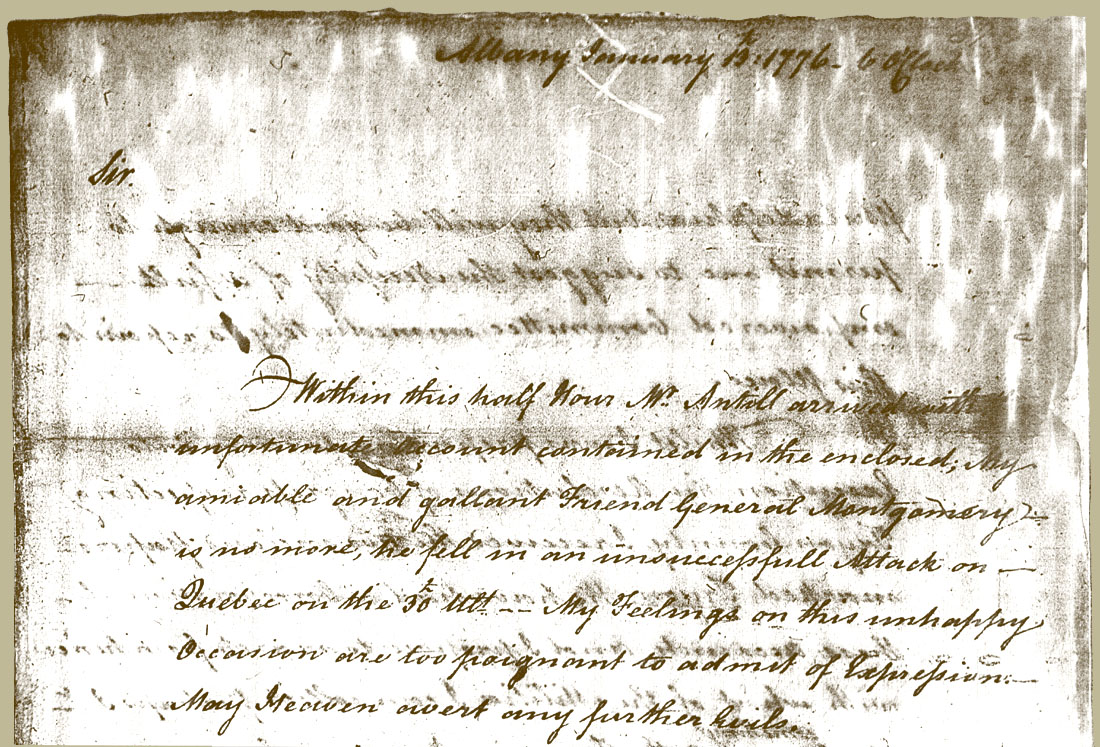
|
Montreal, January 5, 1776.
Sir:—The enclosed letters from Colonel Arnold and Colonel Campbell will inform you of the unhappy fate of our brave and most amiable friend, General Montgomery, who, with his Aid-de-camp, Macpherson, Captain Cheeseman, and several other brave officers and men, gloriously fell in an unfortunate attack on Quebeck—unfortunate, indeed, for in addition to the loss we sustain in the death of the General, one of the bravest men of the age, the flower of the Army at Quebeck were either cut off or taken prisoners. I little expect, with the troops who remain, to be able to continue the siege; in short, our situation in this country is at present, and will be till we have relief from the Colonies, very critical and dangerous. We really have but very few men in the country, and many of those few not to be depended on, as we have too dearly proved. Mr. Antill, a gentleman from Quebeck, whom General Montgomery appointed as Engineer, I beg leave to recommend to you. He was with the General when he fell, and can give you particulars. He is well acquainted with the country, for which reason I have detailed him to proceed on to you, and so to the Congress, knowing that he will be much better able to inform you and them than I am concerning the state of this country, and what will be necessary to be done; unless we have a number of men thrown into this country as soon as they can possibly get over the lakes on the ice, which I apprehend might be done with sleds, and at the same time forward some powder, as we have but four tons in the country at the several posts. We have but one Artillery company, it will therefore be necessary to supply us with another very soon, or we may possibly not only lose the footing we have here, but perhaps all be sacrificed in the country. There is but little confidence to be placed in the Canadians; they are but a small remove from the savages, and are fond of being of the strongest party. Give me leave, also, to remind you of what, I dare say, General Montgomery has done, that we are in the greatest need of cash; hard money we shall soon be in the greatest distress for want of, and doubtless the more so, since the check to our arms. Mr. Price has hitherto supplied us; indeed, I know not how we could have subsisted as an army without him; he has already advanced for us about twenty thousand pounds, and assisted us in every way possible. General Montgomery, in his last letter to me, begged that Price might be mentioned in the strongest terms to the Congress. The necessity of immediate relief, I am sure, will strike your mind very forcibly, when I tell you that our enemies in the country are numerous; the clergy almost universally refuse absolution to those who are our friends, and preach to the people that it is not now too late to take arms against us; that the Bostonians are but a handful of men, which, you know, is too true. Suppose, Sir, that General Washington should detach a thousand men from his Army, if there are no other troops already raised that can be better spared. Something must be done, and that speedily, or I greatly fear that we are ruined. We have but five or six hundred men for the garrisons of this place, Chambly and St. John's. Many of the troops insist on going home, their times of enlistment being out; some, indeed, have run away, without a pass or dismission, expressly against orders. I have been just informed that a Captain Pratt, of the Second Battalion of Yonkers, has led off his company from St. John's. I have given orders to suffer no men to go out of the country, whether they will enlist or not; the necessity of the case, I believe will justify my conduct. [I shall not be able to spare any men to reinforce Colonel Arnold. This place must be secured for a retreat, if necessary.] I called a council of my officers in this place, who were, to a man, agreed that I ought to remain here. I have, therefore, sent Colonel Clinton with Mr. Price, who, I think, will be of great service to him. God only knows what the event will be. This affair puts a very different face upon our interests in this country; however, we must make the best of it. I have ordered General Montgomery's papers to be sent to me; when I receive them I shall conform myself to his instructions. I expected you were at Congress, and had prepared to send this melancholy news to General Washington, as well as to you; but the post arriving last night, I find that you were at Albany; therefore, shall take it to you. I most heartily condole with you, with General Montgomery's friends, and with the country, for so great a public loss. I have the honour to be, your most obedient and very humble servant, David Wooster. To General Schuyler.
|
|
Albany January 13, 1776 6 O'Clock
Sir. Within this half Hour Mr. Antill arrived with unfortunate account contained in the enclosed; My amiable and gallant Friend General Montgomery is no more, he fell in an unsuccessful Attack on Quebec on the 30th Ult. My Feelings on this unhappy Occasion are too poignant to admit of expression. May Heaven avert any further Evils.
|
|
|
|
Janet Livingston, born on August 27, 1743, spent her girlhood at "Clermont", the family home on the bank
of the Hudson River in New York. She married General Richard Montgomery on July 24, 1773, and resided
with him on Livingston Street in Rhinebeck, New York, for a little more than two years before he accepted
a commission as General in the Continental Army. General Montgomery lost his life on December 31, 1775,
while leading his men in the battle of Quebec.
After Richard Montgomery's death, Janet became a prosperous landowner, building an estate with bountiful orchards and farmlands, and a home named "Chateau de Montgomery". Known as a business woman, she capably managed her land interests and established a successful commercial nursery adjacent to her estate. Entertaining family and friends was one of Janet's favorite pastimes. Planting flowers, fruits and trees at her country home at Annandale-on-Hudson, New York, also brought her much pleasure. In a 1809 letter to her brother Edward Livingston, she wrote "If I have a pleasure it is in cultivating my plants...the garden is a sheet of blossoms and flowers." "Chateau de Montgomery" remained in the Livingston family until 1988 when it was purchased by the Historic Hudson Valley. The name was changed to "Montgomery Place" by her brother, Edward Livingston. |

![]() Copyright © 2003, InterMedia Enterprises
Copyright © 2003, InterMedia Enterprises